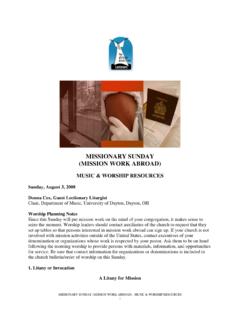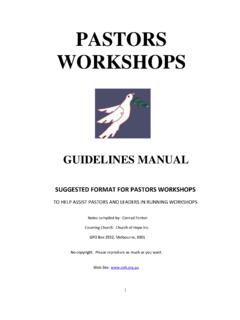Transcription of A Definition of Church Administration
1 1 Key Elements of an Effective Church Administration Strategy By Major Stewart Major Stewart is the Senior Pastor of Mt. Olive Missionary Baptist Church of Flint Michigan. A Definition of Church Administration Church Administration equips the Church to be the Church and to do the work of the Church in a coherent and comprehensive It is the guidance provided by Church leaders as they lead the Church to use its spiritual, human, physical, and financial resources to move the Church toward reaching its objectives and fulfilling its purpose. Church Administration enables the people of God who make up the Church to become and do what they can become and do, by God s grace. ii This Definition of Church Administration has three elements that need to be identified clearly. (1) The overarching concern of Church Administration is the fulfillment of the purposes of the Church of God. Church Administration exists to enable the local Church to fulfill its six-fold purpose: The local Church exists to glorify God (I Cor.)
2 10:31) through loving the Lord and our neighbors (Matt. 22:37-40) by evangelizing people to Jesus, developing people to Christ-like maturity and equipping people for ministry in the Church and world ( : 19-20). Effective Church Administration will help keep the purposes of the Church in focus, while keeping individual responsibilities clear to leaders. The administrative documents will also help keep all involved parties moving in the same direction, minimizing confusion and frustration. Finally, effective written administrative documentation will help maximize human, physical, and financial resources by providing controls designed to ensure good use of resources. (2) This Definition of Church Administration is comprehensive, viewing the administrative task as concerned with every aspect of Church life and seeking to coordinate every experience toward one unified purpose. Administration cannot be confined only to the organizational, programmatic, and promotional aspects of Church life.
3 Worship, preaching, pastoral care, and every other experience within the Church must be seen as interrelated parts of one whole. Each must be viewed in relation to its contribution toward the Church s mission. Conversely, no activity is to be considered an end in itself ( , preaching, evangelistic outreach, finance); but, each is to be an avenue of ministering to the needs of the people, as those needs are defined by the gospel and exposed by the Holy Spirit. (3) This Definition involves all members of the Church in administrative responsibilities the leaders and laypeople. Administration is not the concern only of the pastor and a few key lay people. The entire congregation must understand the nature 2 and mission of the Church and must be involved individually and corporately in glorifying God (I Cor. 10:31), so that the congregation can fulfill its mission. Church Administration Must Be God-Centered and People-Oriented Since the Church is of God, there are certain characteristics that are intrinsic to its very nature that the people must accept and which cannot change by congregational vote.
4 It must be understood that the Church is of God and the reason for its existence is to please God and not people. Likewise, Church administrative policies and procedures are of God in that they provide guided and adequate instructions that will result in God being glorified and loved, and therefore worshiped. The Church Exists to Please God Rather Than Humanity This means that the standard of judgment or measurement for any successful activity, ministry or program in the Church is based upon whether or not God s glory is attained (I Cor. 10:31). Crowded sanctuaries on Sunday and many well-attended programs during the week may indicate an active and popular Church , but not necessarily an effective one. A God-centered Administration model measures it success by whether or not the activities, ministries or programs glorify God (I Cor. 10:31), and strengthen ones love for God and others (Matt. 22:37-40) rather than on attendance and neatly executed programs.
5 Church Administration Must Be People-Oriented Even though the Church is of God, it is for people. It is for people in that the model should be concerned with people and their needs. The study of the nature of the Church makes it clear that God s purpose for the Church is to be fulfilled in and through the people. Every aspect of the life of the Church derives its importance and relevance from their contribution toward whether or not the activities, ministries or programs contribute positively towards evangelizing people to Jesus, developing people to Christ-like maturity and equipping people for ministry in the Church and world (Matt. 28:19-20). The experiences of the Church , recorded in the Old (Exodus 20:1-17) and New (Mark 6:30-44) Testaments indicate how effective Church Administration models are of God but are designed for people. As stated previously, they are of God in that they provide guided and needed instructions that will result in God being glorified and loved and therefore worshiped.
6 They are for the people in that, when Church Administration is adhered to, people are coherently evangelized to Jesus, developed to grow, and equipped for ministry. An Effective Church Administration Strategy Planning To assure you have a strategy that will work for you and your Church , you must develop a solid work plan. There are numerous benefits to using a plan rather than doing ministry by accidentiii : 1. Planned ministries lead to progress instead of mere repetition. 3 2. Planning builds continuity in the Church s program. 3. Planning reflects unity of ministries supporting one another. 4. Proper planning develops effective leaders and members, and brings others to Christ. Organization Next, you need good organization: 1. Good organization distributes the workload. As Jethro told Moses about his assignment, The thing is too heavy for you; you are not able to perform it alone (Exodus 18:18, RSV). No one is strong enough or smart enough to do it all.
7 2. Good organization places responsibility where it belongs. Each spiritually gifted person, in the Church , is responsible for using his or her God-given spiritual gift for the total edification of the Church . A good organizational structure will help position and place the various gifts in their proper places of ministry. 3. Good organization reduces confusion. Confusion is minimized when responsibility is placed where it is supposed to be placed. 4. Good organization helps avoid unnecessary duplication of effort. Dr. Tidwell believes strongly that Duplication of effort is at best a waste, and at worst counterproductive. iv Good organization reduces the possibility of over stepping job related boundaries. A Financial Plan The Church Administrator needs a solid financial plan that includes the following: 1. An adequate perspective about money. The pastor has to be involved in the financial matters of the Church in order to influence a healthy perspective about money.
8 It is important for the people to understand that even though money isn t everything, it does solve many problems. The people should have a good perspective on taking care of the pastor as well as the physical maintenance of the Church building(s) and programs. Jesus spoke very often about money, more than he spoke about any other subject in the Bible. It is important. 2. A Sound Budget. A budget is a comprehensive financial plan that reflects the specific amounts of money allocated from anticipated income for supporting the Church s ministries and related expenses for a definite period of time. A minimum of 10 weeks is typically needed to adequately develop, prepare, and present a ministry budget. The following represents typical steps and timeline that make ministry budgets a simpler process: Weeks Before Adoption Action To Take Step One: Ministry Analysis 1. How well are we doing? 2. How may we improve? 4 3. Anticipate Sources of Income.
9 Income sources includes tithes and offerings; gifts for special causes; rental fees from properties; memorial gifts; interest 3. What new endeavors need consideration? 10 weeks before adoption Step Two: Ministry-Action Proposals 1. Elect budget committee. 2. Committees and organizations study needs. 3. Each committee and organization prepare proposals. Ministry Action Budget Committee Responsible for these steps: 8 weeks before adoption Step Three: Evaluation of Ministry Actions 1. What contribution to purpose of Church ? 2. Will it assist Church to reach its major objectives? 5 weeks before adoption Step Four: Prepare Budget 1. Group budget items by ministry areas. 2. Prepare ministry action proposals in descriptive paragraph form. 3-5 weeks before adoption Step Five: Present Budget 1. Style budget so that all ministries are clearly seen. 2. Directors and chairmen are present to discuss budget proposals. Stewardship Chairman, Budget Committee, Church Staff Responsible for these steps: One week before Step Six: Promote the budget 1.
10 Every member presentation. 2. Alternate: Dedication Day and follow-up visitation. Step Seven: Report on ministry progress 1. Accounting of expenditures. 2. Progress toward program goals. 3. Creative presentations. Step Eight: Start the process over again!!!v 5 income on money invested; trusts; wills; refunds of money from vending machines and from meals sold; capital gifts and other sources. 4. Secure Commitment to Support the Budget. Some of the ways to lead Church members to support the budget include: Revivals; Building Fund Programs; Specific Funded Programs, such as Church renovations, new carpet, upgraded audio/visual equipment, etc.; scholarships; Tithers Commitment Program; and a Stewardship Revival Program. 5. Use Orderly Plans for Receiving Money. When envelopes are used income increases. Maximum security should be considered for collecting money. 6. Systematize Counting and Banking. Regardless of the size of the Church , there should always be more than one person counting the money to avoid his or her integrity being open to question.

















